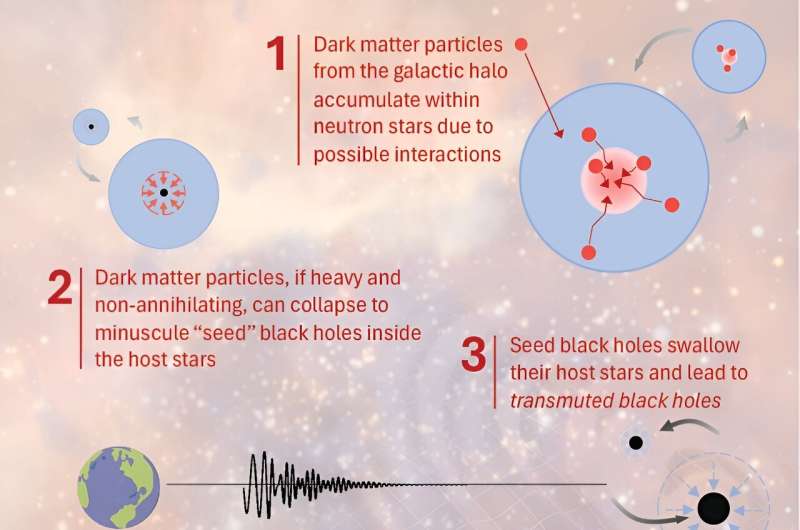This article has been reviewed according to Science X's editorial process and policies. Editors have highlighted the following attributes while ensuring the content's credibility:
fact-checked
peer-reviewed publication
trusted source
proofread
Gravitational wave detectors as probes of dark matter

Dark matter is a keystone assumption in the current understanding of the universe. Yet, the elemental identity of dark matter is not known, and its future discovery remains a primary goal in the fields of cosmology and particle physics.
A team of theoretical physicists from the Tata Institute of Fundamental Research in Mumbai, the Indian Institute for Science in Bengaluru, and the University of California at Berkeley, have proposed a new method to probe dark matter. The method leverages gravitational wave searches to look for dark matter through its predicted effects on neutron stars.
Sulagna Bhattacharya, graduate student at TIFR and lead-author of the study published in Physical Review Letters, explains—dark matter particles in the galaxy can accumulate in neutron stars due to their non-gravitational interactions. The accumulated particles form a dense core, that collapses to a minuscule black hole in the scenario that dark matter particle is heavy and has no antiparticle counterpart; a scenario that has proved difficult to test otherwise in laboratory experiments.
For a large allowed range of dark matter particle mass, the initial seed black hole consumes its host neutron star and transmutes it to a neutron-star-mass black hole. Crucially, theories of stellar evolution predict that black holes form when neutron stars exceed about 2.5 times the mass of the sun, as encoded in the Tolman-Oppenheimer-Volkoff limit, but here dark matter leads to low-mass black holes that are typically smaller than the maximal neutron star.
Anupam Ray, who co-led the work, points out that "for dark matter parameters that are not yet ruled out by any other experiment, old binary neutron star systems in dense regions of the galaxy ought to have evolved into binary black hole systems. If we do not see any anomalously low-mass mergers, it puts new constraints on dark matter."
Intriguingly, some of the events detected by LIGO, e.g., GW190814 and GW190425, appear to involve at least one low-mass compact object. A tantalizing suggestion, based on pioneering work by Hawking and Zeldovich from the 1960s, is that low-mass black holes could be of a primordial origin, i.e., created by exceedingly rare but large density fluctuations in very early universe.
Motivated by these considerations, the LIGO collaboration has undertaken targeted searches for low-mass black holes and set limits. The present study by Bhattacharya and collaborators shows that same non-detection of low-mass mergers by LIGO also puts stringent constraints on particle dark matter.
The constraints presented in this study hold significant value, as they explore parameter space that is well beyond the reach of the current terrestrial dark matter detectors like XENON1T, PANDA, LUX-ZEPLIN, especially for heavy dark matter particles.
Mergers of low-mass black holes are expected to be detectable not only using existing gravitational wave detectors such as LIGO, VIRGO, and KAGRA, but also by upcoming detectors like Advanced LIGO, Cosmic Explorer, and the Einstein Telescope. By considering the planned upgrades of current gravitational wave experiments, and accounting for their increased sensitivity and observation time, the study forecasts the constraints that could be obtained within the next decade.
In particular, the study shows, gravitational wave observations can probe extremely feeble interactions of heavy dark matter, well below the so-called "neutrino floor" where conventional dark matter detectors have to contend with the astrophysical neutrino backgrounds. Instead, if exotic low-mass black holes are discovered in the future, it could be a valuable hint about the nature of dark matter.
The authors sign-off optimistically noting, "gravitational wave detectors, which have already proved useful for the direct detection of black holes and gravitational waves predicted by Einstein, may end up as a powerful tool to test theories of dark matter as well."
More information: Sulagna Bhattacharya et al, Can LIGO Detect Nonannihilating Dark Matter?, Physical Review Letters (2023). DOI: 10.1103/PhysRevLett.131.091401
Journal information: Physical Review Letters
Provided by Tata Institute of Fundamental Research





















